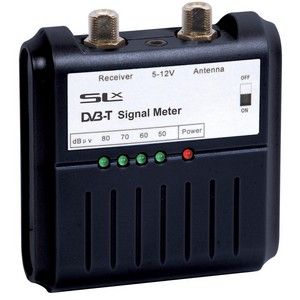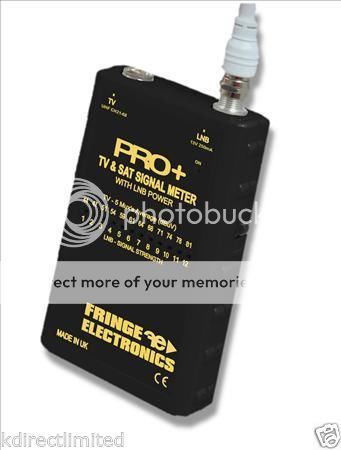They're measuring a very weak voltage. If you look at the Fringe Sat & TV 'Pro' version the scale is marked up in dBµV. The µV is micro volts, so that millionths of a volt. The dB bit is the logarithmic scale, so it's not a linear increase as a volt meter would measure.
Are they any good? .......... as a rough guide tool they're okay. Bear in mind a couple of things though. They're measuring signal level only so there's no usable information about signal quality. They're also measuring the signal level averaged across the entire transmitter frequency range, so they're a bit of a blunt instrument in that respect too.
This is important for two reasons. The first is the strength of the different channel mux frequencies varies. For example, the main BBC and ITV muxes (BBC A and D3 & 4) are each a high power transmission to achieve the target of high UK coverage. The other commercial muxes for channels such as Dave, E4 etc (SDN, ARQA, ARQB) aren't nearly so powerful. So the meter might show you very high signal level as an average but there's no way to look at the strength of say ARQA in isolation. The mux groups and their channels are shown
here
The second thing about average measurement is that you can't tell if you are measuring your transmitter or an adjacent one. So you could do with a compass to make sure your aerial is pointing at the main mast for your area.
The DIY Pro meter and compass are shown [/url]
here on the Satcure web site
A word on mobile phone compass apps. Most of them I've used are rubbish. I don't know if it's me and I'm magnetised or something but their accuracy is pants. Both Apple and Samsung give me +/- 20 degrees inaccuracy. They're useless. A proper compass is much better.
In summary...
Bearing in mind that my Horizon professional meter was the better part of £400, then spending £20~£30 isn't going to produce the same results and you wouldn't expect it to. As long as you can work with the limitations then a DIY meter with a compass should give you a reasonable result. I'd spend the extra though on the Pro version though. The £10 meters have a very coarse scale. The better versions have more range and a finer scale.
Epilogue
Purely to satisfy my own curiosity I got hold of an SLX meter...

and a Fringe Pro+ meter...

to compare readings against my Horizon meter. Now I'm not suggesting this is scientific or rigorous, so please don't read too much in to this beyond the basic "Is it any use".
My reference aerial is an unamplified log periodic. The transmitter is Winter Hill (NW England) and I'm picking all the muxes except MEN which is there but not strong enough to give a watchable picture. The signal measured at the TV end of the aerial cable is 56dB for the strongest Mux (BBC A) The maximum deviation in signal level is -2dB for the weakest signal on just on Mux. The others are -1dB so the slope is much flatter than with a typical "High Gain" wideband aerial.
I changed the termination on the end of the aerial cable to suit each meter (F type for the SLX and my reference Horizon meter, and Belling-Lee "TV coax" plug for the Fringe meter.) I also had a couple of 0~10dB variable attenuators; one each for the different connection types.
Measuring signal with the SLX: The scale on the SLX meter reads in 10dB jumps and runs from 50dBµV to 80dBµV. That's just about enough to cover 45dBµV at the TV when there's a long cable run. But if the signal at the mast is a bit marginal then you might not have enough to light even the first LED on the scale. My guess is that a lot of DIY'ers would interpret that as a faulty meter or an aerial problem. As a diagnosis tool on it's own then the meter itself has limited value. The other thing is the scale jumps are too big for fine tuning. 10dB steps means a signal has to be 3 times greater each time to light the next LED in the scale. That amount of signal change might only occur with the aerial pointing 10 or 15 degrees off target. Once it's roughly on the correct bearing then the change in signal level might be as little as 3 or 4dB over a small arc. That would be enough to stop the weaker mux signals from getting to the TV.
So long as there's enough signal at the mast head then the usefulness of the SLX can be improved with a variable 0~10dB attenuator. This works by reducing and trimming the signal level to a point where the step LED is barely illuminated. Changing the aerial direction slightly will result in a change of brightness of the LED because it is just on the threshold of that step; the LED will either get brighter or go out. If it goes out then reverse the direction of the turn. If the LED gets brighter then increase the attenuation setting a fraction and then continue the direction of the turn until the LED goes past peak brightness again. Repeat until the direction hunting is complete.
SLX meter accuracy: I measures the peak signal strength with my Horizon meter. It registered 56dBµV for the strongest Mux signal. Using the variable attenuator I'd estimate that the SLX was reporting a similar level.
Measuring signal with the Fringe Pro+: The scale on the Fringe SLX meter reads in 3dB jumps and runs from 44dBµV to 81dBµV. The lower start point gives this meter an advantage when signal hunting. It also makes it potentially more useful as a set back diagnosis tool.
The same trick with the variable attenuator can be employed here as with the SLX meter (see above).
SLX meter accuracy: The Fringe meter reported the average signal level as 71dBµV. This could be because the meter is displaying the compound aggregate of 5 muxes, or it may be that it is not as accurate. The user manual suggests an accuracy of +/-2% though. If just using the meter as a signal finder then this isn't such a big issue. However, if trying to set levels with variable mast head amps to compensate for distribution losses then this might be difficult with this meter. More information is required.




